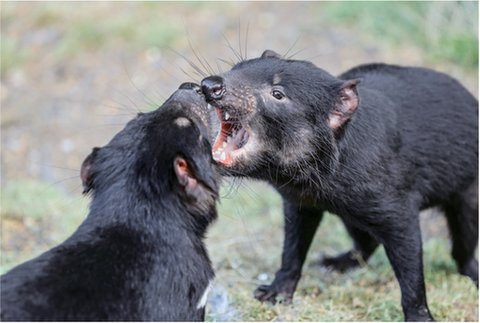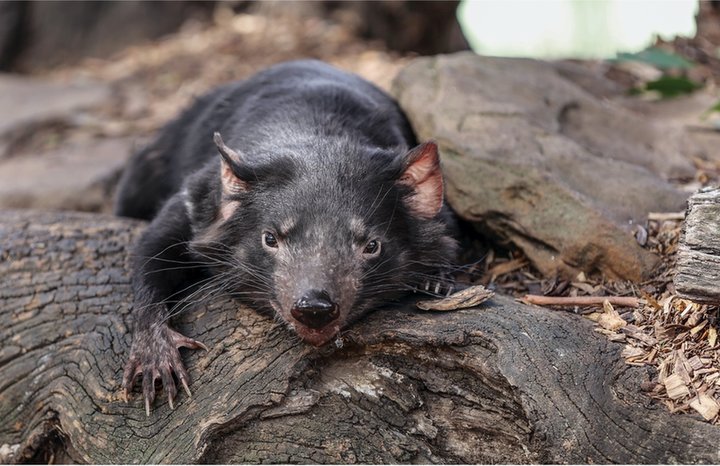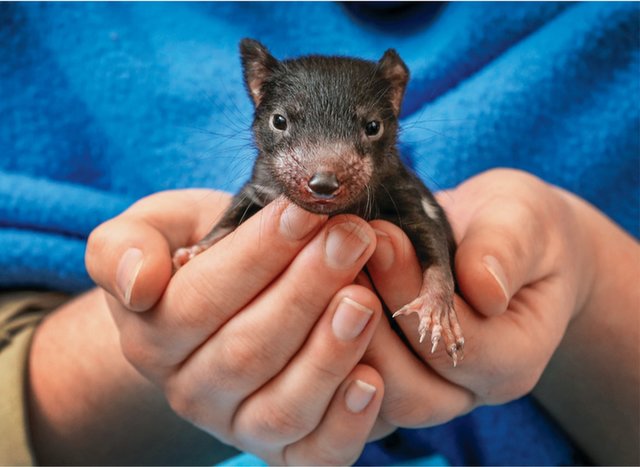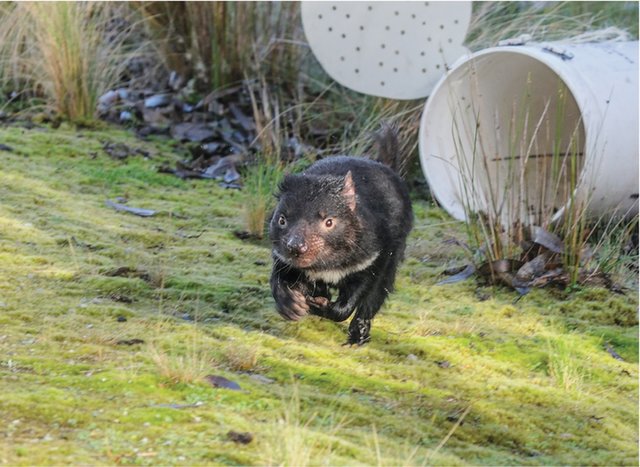IntheWild
Devilsarenocturnalandusuallysolitary.Butthatchangeswhenfoodisinvolved.Devilshaveanexcellentsenseofsmell.Theycandetectcarrionfrom0.8kilometers(abouthalfamile)away.Oncetheysmellit,theycantrackit fast.
Devilsquicklyestablishanorderaboutwhoeatswhatandwhen.They“growl-whine,”“screech,”“sneeze,”and“shriek.”Eachsoundmeansadifferentthing.A“discussion”aboutadeadwombatmightstartoutwithsnortsandgrowls.But,itcanquicklybecomefull-on shrieking.
Tasmaniandevilsusetheirexcellentsenseofsmelltoavoidpredatorsandlocatepreyand carrion.

TheseTasmaniandevilshavea“discussion”over dinner.
Atacarcass,anumberofdevilsallwanttoeat.Thesesoundsestablishanordertothechaos.Devilscombinetheirsoundswithbiting.Theyusetheirjawstosnapateachother.Andthisiswheretheirtroubleasaspecies began.
TroubleinTasmania
In1996,aphotographertookapictureofsomedevilsontheisland.Theirfacesweredistortedbylargetumors.He’dneverseenanythinglikeitandshareditwithsomescientistshe knew.
By2002,scientistslearneditwasatypeofcancer.Typically,cancercannotbe“caught.”Thecellsfromoneindividualaredifferentfromanother’s.Yet,whatwasattackingdevilswasoneofveryfewcancersthatcanspreadfromoneanimaltoanother.Itiscalleddevilfacialtumordisease.Anditisfatal.Say,onedevilhasitandbitesanother.Bothdevilswilldie.Sincedevilsoftenbiteeachotherduringtheirfightsoverfood,thediseasespread quickly.

AcancerspreadsbetweenTasmaniandevilswhensickanimalsbitehealthy ones.

ayoungTasmanian devil
Whydidn’tthedevil’sbodyfightthecancercells?Itturnsoutthatthistypeofcancercan“hide”fromadevil’sdefensesystem.Thedevil’sbodythinksthecancerispartofitsbody.So,itsbodydoesn’tfightback.Thecancercontinuestogrow.Foraninfecteddevil,thiscanleadtostarvation.Thecancergrowssolargeonthedevil’sface,thedevilcannolonger eat.
Devilsweredying.Manyscientistsfearedthedevilwouldbecomeextinct.But,that’snotwhat happened.
ProgressWithProtection
Almostimmediately,wildlifeofficersremovedhealthydevilsfromthewild.Acaptivebreedingprogrambegan.ThisensuredthatahealthypopulationofTasmaniandevilswouldthrive.Wildlifeofficersalsosetupsafetrapsforcatchandreleasetorecorddevils’ health.

Captivebreedingprogramsensuredapopulationofdisease-free devils.
Thisdevilisreleasedfromatrapthathelpsscientistsmonitordevil health.
Inthelab,theystudiedthediseaseitself.Couldtheycreateavaccinetoprotectdevils?Scientistsarehopefulthattheywill.Atthesametime,theyareseeingsomecasesofpreviouslyinfecteddevilsthatareregainingtheirhealth.How?Perhaps,theirbodiesarebeginningtoadapttofightthe disease.
Thisispromisingnews.Tasmaniandevilsplayahugeroleasscavengersintheirecosystem.Theyarelovedaroundtheworld.Theirrecoveryis important!

